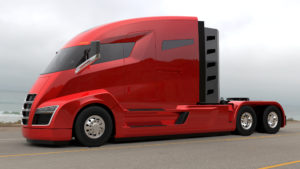Tesla Makes Helping Puerto Rico Job One!

The New Tesla Semi-Truck could very likely change the world’s transportation system. Photo: nikolamotor.com
By George Harvey
Tesla’s Elon Musk was all set to unveil the new Tesla Semi-Truck at an event scheduled to take place on October 26 at the Design Center in Hawthorne, California. While there were a few glitches, they were not unmanageable. The roll-out of the Tesla Model 3 was not going smoothly, and there were other problems, but Musk tweeted in satisfaction about his new semi. It has a range of 300 miles, which is impressive. And it looked sleek.
Things were still progressing until Puerto Rico was hit by Hurricane Maria, producing a series of humanitarian, economic, political, and possibly technological shockwaves. While Puerto Rico may be a long way from Hawthorne, it eventually set back Tesla’s schedule by weeks. And while that may seem a disappointment for those of us who love road vehicles, what is unfolding seems definitely to be worth being excited about.
When Hurricane Maria hit Puerto Rico on September 20, things were already bad. The local utility, the Puerto Rico Electric Power Authority, had $9 billion in debt and was already bankrupt. Years had passed since it had resources to keep infrastructure in repair. There were still 80,000 people on the island who had not gotten their power back after Hurricane Irma, about two weeks earlier. When Maria left the island, it was altogether devastated.
Governor Ricardo Rossello quickly began sending messages saying the situation in Puerto Rico was desperate. No one had electric power, and Rossello said he expected it would take months to restore it to the entire island. Water was unavailable to 60% of the people. Many roads were impassable. Food supplies were certainly going to be a problem. The only place where there was cell phone reception was for those operating on backup power.
It took President Trump ten days to appoint a lieutanant general to supervise disaster recovery. He quickly gave his administration an A+ grade on its efforts and told the Puerto Ricans that there had been worse storms. (We might mention some facts for the record. Hurricane Harvey was a 25,000-year event and the most expensive storm ever to hit the country by a wide margin. Two weeks later, we had Hurricane Irma, the most powerful storm on record to have formed over waters of the Atlantic Ocean. Two weeks after that came Hurricane Maria, the most intense of the three, in terms of central pressure.)
On October 5, an individual named Scott Stapf tweeted a question, “Could @elonmusk go in and rebuild #PuertoRico’s electricity system with independent solar & battery systems?”
Elon Musk responded on the same day, tweeting, “The Tesla team has done this for many smaller islands around the world, but there is no scalability limit, so it can be done for Puerto Rico too. Such a decision would be in the hands of the PR govt, PUC, any commercial stakeholders and, most importantly, the people of PR.”
This produced a response from Governor Rossello within only about two hours, “@elonMusk Let’s talk. Do you want to show the world the power and scalability of your #TeslaTechnologies? PR could be that flagship project.”
In very short order, Musk and Rossello were on the telephone. Their conversation lasted twenty-five minutes. But the results of the conversation have the potential to be historic.
Elon Musk soon announced that the Tesla Semi-Truck unveiling would have to wait until November 16th, while batteries were made for Puerto Rico. As this is written, several hundred Tesla batteries have already arrived, along with a number of Tesla employees, who are setting them up with solar panels to produce microgrids.
Elon Musk is a man who clearly likes to put on a good show. Delaying the Semi-Truck presentation was probably not entirely easy for him. But it seems that when he gets into something he thinks is important, he acts decisively. He donated $250,000 of his own money to Puerto Rican recovery efforts.
Elon Musk and Tesla are not the only ones helping out. Google is testing a new technology to restore internet service. Facebook has donated $1.5 million to relief organizations. Other organizations that are helping out include Airbnb, Uber, and Lyft. But Tesla’s efforts in Puerto Rico might actually result in widespread use of renewably-powered microgrids that can act independently of any fossil fuels.
As I write this, three weeks after Hurricane Maria hit, only 15% of the people on the island have electric power. The federal government’s reaction to the crisis has been labeled “genocidal neglect.” And President Trump is sending tweets blaming the Puerto Ricans themselves for the humanitarian crisis and saying that federal help cannot last forever.
One Vermont installer is crowdfunding a solar system in Puerto Rico. Anyone interested can visit http://bit.ly/Puerto-Rico-fundraiser.
New Tesla Semi-Truck posted first on Green Energy Times
No comments:
Post a Comment